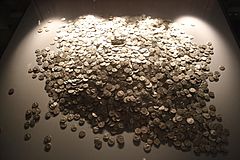Shapwick Hoard facts for kids
Quick facts for kids Shapwick Hoard |
|
|---|---|

Coins from the Shapwick Hoard on display at the Museum of Somerset
|
|
| Material | Coins |
| Size | 9,262 coins |
| Period/culture | Romano-British |
| Discovered | Shapwick, Somerset by Kevin and Martin Elliott in September 1998 |
| Present location | Somerset County Museum, Taunton |
| Identification | 1998–99 Fig 294.1–9; 2000 Fig 251 |
The Shapwick Hoard is a huge collection of 9,262 Roman coins. It was found in Shapwick, Somerset, England in September 1998. A "hoard" is a hidden collection of valuable things.
These coins were very old, dating from 31–30 BC up to 224 AD. The collection was special because it had two rare coins never seen in Britain before. It also contained the largest number of silver denarii (a type of Roman coin) ever found in Britain.
Contents
Finding the Ancient Roman Coins
How the Shapwick Hoard Was Discovered
The Shapwick Hoard was found by two cousins, Kevin and Martin Elliott. They were amateur metal detectorists, which means they used special equipment to find metal objects underground. They found the coins in a field in Shapwick.
Uncovering a Roman Villa
When experts dug up the site, they found something amazing. The coins had been buried in the corner of a room. This room was part of a Roman building that no one knew about before. After more digging, they realized the room was part of a large Roman villa, which was like a fancy country house.
Valuing the Treasure
After the coins were found, a special meeting called a "treasure inquest" was held in Taunton. Here, the hoard was officially declared "treasure." This meant it was very important and belonged to the public. The hoard was valued at £265,000.
The Museum of Somerset in Taunton Castle bought the hoard. They got help from the National Heritage Memorial Fund and other groups. Today, you can see the Shapwick Hoard on display at the museum. Later, Kevin and Martin Elliott found 23 more coins, valued at £690, which were added to the hoard.
What Was Inside the Shapwick Hoard?
Coins from Roman Emperors
The Shapwick Hoard contained many interesting coins. There were 260 coins from the time of Mark Antony, a famous Roman general, dating back to 31–30 BC. More than half of all the coins were made during the rule of Septimius Severus, who was emperor from 193 to 211 AD.
Rare and Unique Coins
Two coins in the hoard were very rare. They showed Manlia Scantilla, the wife of an emperor named Didius Julianus. He was murdered just four weeks after these coins were made. These coins had never been found in Britain before.
The hoard also had some coins that were not Roman. These included three Lycian drachmae and one drachma from Caesarea in Cappadocia. The newest coin in the hoard was made in 224 AD. Experts believe the entire hoard was worth about ten years' pay for a Roman soldier.
Breakdown of Coins by Emperor
Here is a list showing how many coins were found from different Roman rulers:
| Reign | Date | Number of Coins |
|---|---|---|
| Mark Antony | 31 BC | 260 |
| Nero | 54–68 | 44 |
| Galba | 68–69 | 12 |
| Otho | 69 | 9 |
| Vitellius | 69 | 30 |
| Vespasian | 69–79 | 548 |
| Titus | 79–81 | 69 |
| Domitian | 81–96 | 21 |
| Nerva | 96–98 | 12 |
| Trajan | 98–117 | 91 |
| Hadrian | 117–138 | 117 |
| Antoninus Pius | 138–161 | 567 |
| Marcus Aurelius | 161–180 | 171 |
| Commodus | 180–192 | 356 |
| Septimius Severus | 193–211 | 5,741 |
| Caracalla | 198–217 | 345 |
| Macrinus | 217–218 | 61 |
| Elagabalus | 218–222 | 688 |
| Severus Alexander | 222–235 | 120 |
Other Hoards Found in Shapwick
Shapwick has been a place where many hoards have been found over the years. However, the 1998 discovery was by far the biggest.
- In 1868, fourteen coins from 306–361 AD were found in a peat bog (called a turbary) in Shapwick. These coins were given to the Glastonbury Museum in 1948.
- Between 1936 and 1938, four more hoards were found very close to each other:
- Hoard A: This included a pewter cup holding a pottery beaker. Inside the beaker were 120 silver coins called siliquae, from the mid-fourth to early-fifth century. It also had a pewter saucer and a platter.
- Hoard B: This hoard had a pottery beaker inside a pewter jug. It contained 125 silver siliquae from the same time period as Hoard A.
- Hoard C: This was a pewter container with about 1,170 bronze coins. These coins dated from 320–390 AD, with most from the time of the Valentinianic dynasty (364–375 AD).
- Hoard D: This hoard contained a bronze-cased wooden tankard (a large drinking cup), a pewter bowl with a stand, and a bronze bowl. These items are thought to be from the late fourth century.
- In 1978, over 1,000 copper coins were found inside a pewter pot. These coins were from 305–423 AD.

